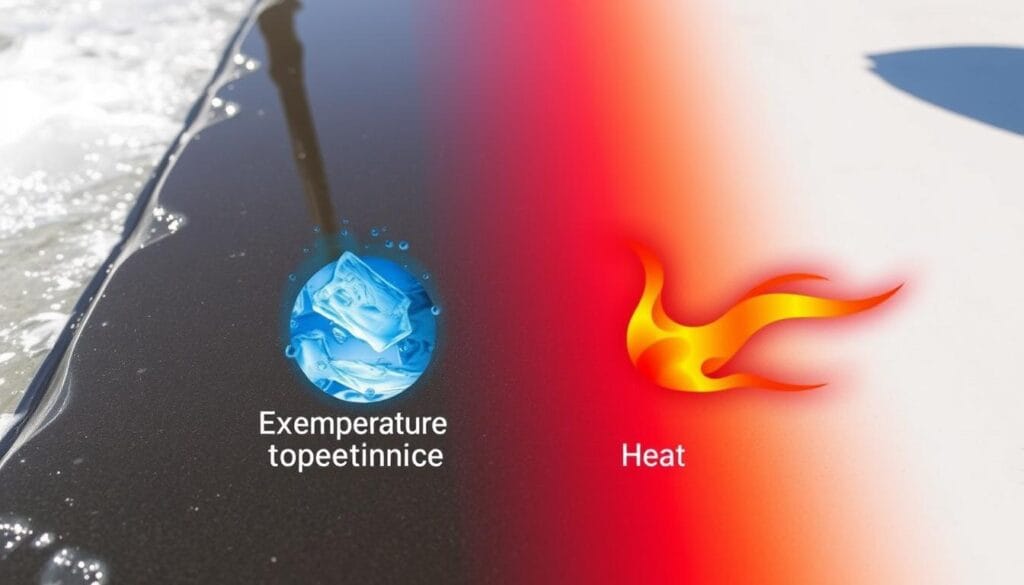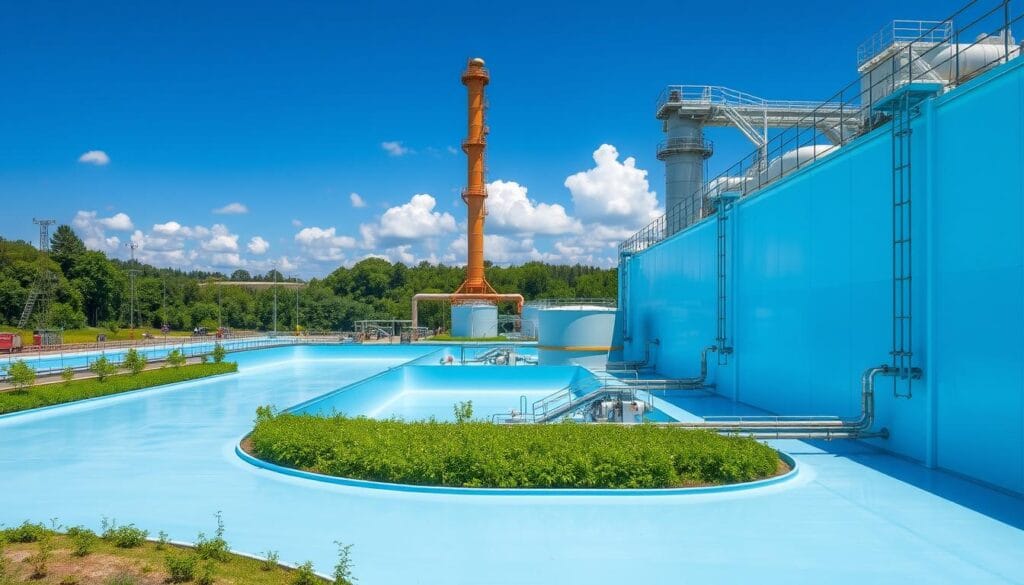Introduction
Polyurea coatings are revolutionizing wastewater infrastructure protection. Designed for polyurea wastewater and polyurea sewer coating applications, these advanced solutions resist harsh chemicals, endure extreme temperatures, and cure rapidly—slashing downtime for treatment plants.
Polyurea wastewater coatings have emerged as the gold standard for protecting water treatment infrastructure. These advanced coatings offer unmatched chemical resistance, exceptional durability, and rapid installation capabilities, making them ideal for sewer coating applications and wastewater treatment facilities. This comprehensive guide explores why polyurea has become the preferred choice for protecting critical water infrastructure.
Table of Contents
Key Takeaways
- Unmatched defense against corrosion, cracks, and chemical exposure in polyurea wastewater coatings.
- Rapid curing (10–15 seconds) minimizes facility downtime.
- 25+ year lifespan reduces maintenance costs by up to 60%.
Understanding Polyurea Wastewater Treatment Coatings
Polyurea wastewater treatment coatings are formed through an advanced chemical reaction that creates exceptionally strong molecular bonds. This unique chemistry delivers superior chemical resistance, outstanding structural integrity, and excellent waterproofing capabilities, making them ideal for critical wastewater infrastructure protection.
These specialized sewer coatings withstand extreme conditions, providing comprehensive protection against:
- Corrosive environments
- Structural cracking
- Impact damage
- Continuous abrasion
- Chemical exposure
The rapid cure time of 10-15 seconds significantly reduces installation time and labor costs, making polyurea coating systems a cost-effective choice for wastewater treatment facilities. Their superior adhesion to various substrates, including steel and concrete, combined with exceptional impact and crack resistance, ensures long-term protection with minimal maintenance requirements.
The Evolution of Wastewater Infrastructure Protection
The United States faces significant challenges with aging wastewater infrastructure. Polyurea sewer coatings and liners have become an essential solution, providing long-term protection that substantially reduces rehabilitation costs. Their superior performance compared to traditional methods has made them the preferred choice for modern infrastructure protection.
Traditional Coating Methods vs Modern Solutions
While conventional cement-based repairs often fail prematurely due to hydrogen sulfide gas exposure, polyurea coatings offer superior crack-bridging capabilities up to 0.125 inches. Their decades-long service life significantly outperforms traditional cement-based solutions, providing more reliable and durable protection.
Environmental Regulations and Compliance
The Environmental Protection Agency has strict rules for wastewater plants. They must treat pollutants before sending waste to sewers. Polyurea coatings help cities follow these rules, keeping their wastewater infrastructure in good shape.
Cost-Effective Infrastructure Management
New coating tech, like polyurea, has made fixing infrastructure cheaper. These coatings make the infrastructure last longer and need less maintenance. This is a smart and affordable choice for cities.
| Product | Benefit |
|---|---|
| MeCaFix 100 | Fast-curing repair paste that cures ten times faster than traditional fast-setting epoxy repairs |
| MeCaWrap W4 | Water-activated composite wrap offering pressure resistance up to 27 bar (400 psi) and allowing quick return to service within ten minutes |
| MeCaWear 306 | Two-component silicon carbide novolac polymer providing a protective barrier against wear, corrosion, and chemical attack |
Chemical Properties and Composition of Polyurea Coatings
Polyurea coatings are a top choice for protecting wastewater treatment plants. They are Created from a special mix of chemicals. This makes them strong and flexible, with great properties.
Isocyanates and polyamines are the main parts of polyurea coatings. They quickly bond to create a tough polymer. This gives polyurea its amazing strength, flexibility, and ability to withstand cracks.
Polyurea coatings have a low VOC content, which is good for the environment. This makes them a green choice for industrial coatings in wastewater treatment.
Polyurea dries fast, often in seconds. This is a big plus. It means projects can finish quicker, and facilities can start using them again sooner.
These coatings also resist many chemicals found in wastewater. This keeps the infrastructure safe and sound for a long time.
| Chemical Property | Characteristic |
|---|---|
| Composition | Isocyanates and polyamines |
| Elongation | Up to 400% |
| Crack Bridging | Exceptional |
| Hardness | High |
| Tensile Strength | Impressive |
| VOC Content | Low |
| Curing Time | Rapid (Seconds) |
| Chemical Resistance | Excellent |
Polyurea coatings are a top pick for protecting wastewater treatment plants. They last long and work well in tough conditions.
Key Benefits of Polyurea in Wastewater Treatment
Polyurea coatings are a top choice for protecting wastewater systems. They offer corrosion protection that lasts, is easy to apply, and cures fast. This makes them a favorite for keeping wastewater treatment facilities safe.
Superior Chemical Resistance
Polyurea coatings can handle the tough chemicals in wastewater, like hydrogen sulfide gas. They create a strong barrier that protects concrete and metal from corrosion. This helps extend the life of important infrastructure.
Exceptional Durability and Longevity
Polyurea spray-applied coatings are tough and flexible. They can handle the challenges of wastewater treatment, like impacts and extreme temperatures. This means less maintenance and longer-lasting protection for facilities.
Rapid Curing and Installation Benefits
Polyurea coatings dry quickly, even in cold weather. This means less time waiting and faster repairs. Their smooth application also means fewer weak spots, making the system stronger and more reliable.
Using polyurea in wastewater treatment brings many benefits. It offers corrosion protection, extends the life of infrastructure, and saves on maintenance costs. It also helps meet environmental rules and standards.
Application Methods and Installation Processes
Polyurea coatings are a great way to protect wastewater treatment systems. They can be sprayed directly onto concrete or similar surfaces after they’re ready. You can also spray the polyurea onto fabric panels first, then attach them to the surface. This method might not need as much repair work.
Applying polyurea coatings is quick. You can spray it all at once, which means structures can be ready to use soon. It dries in just 10-15 seconds, making it work well with many surfaces.
| Application Method | Key Benefits |
|---|---|
| Direct Spray Onto Substrate | Streamlined surface preparation Faster installation time Suitable for a variety of substrates |
| Pre-Spray onto Geotextile Panels | Mitigates the need for extensive crack repair Provides a seamless, monolithic protective barrier Enhances the overall durability of the system |
Polyurea coatings are a top pick for industrial coatings and protective linings in wastewater treatment. They dry fast, resist chemicals, and last a long time. This makes them a key part of keeping infrastructure safe and sound.
Temperature Resistance and Environmental Adaptability
Polyurea coatings can handle extreme temperatures, making them perfect for wastewater infrastructure and other protective coatings. They work well in temperatures from -40 to 350°F (-40 to 176.7°C). This means they can perform well even in harsh weather.
Freeze-Thaw Cycle Performance
Polyurea coatings are great at handling freeze-thaw cycles for decades. They are flexible and durable, moving with the structure as it changes with the seasons. This ensures they protect well, even in areas with big temperature changes.
Extreme Temperature Tolerance
Polyurea coatings also handle extreme temperatures well. They stay strong in both hot summers and cold winters. This keeps the wastewater infrastructure they protect safe.
These coatings adapt to many environmental conditions. They handle sudden temperature changes and high humidity. This makes them a solid choice for many protective coatings needs, especially in tough climates.

Crack Bridging and Structural Protection Capabilities
Polyurea coatings are great for infrastructure rehabilitation and waterproofing. They can bridge cracks up to 0.125 inches wide. This makes them a strong, waterproof, and durable liner for structures.
These coatings are flexible and stretch with the structure. They don’t crack or peel, offering long-lasting protection. This is perfect for places where leaks must be stopped and the structure must stay strong.
- Polyurea Rayston can bridge cracks, with a gel time of 4 seconds at 25ºC and 3 seconds at 60ºC.
- The tack-free time for Polyurea Rayston is just 30 seconds at 70ºC, allowing for quick curing and installation.
- Polyurea Rayston’s crack-bridging properties are rated as Class A5 at -10ºC for static properties and Class B4.2 at 23ºC and -20ºC for dynamic properties, according to EN -1062 -7 methods A and B.
Polyurea coatings create a seamless, waterproof barrier. They stop leaks and keep the structure strong. This makes them a great choice for many infrastructure rehabilitation and waterproofing needs.
Secondary Containment Applications
Polyurea coatings are perfect for secondary containment in wastewater treatment facilities. They are great where chemicals or hazardous materials are stored. This creates a strong barrier against spills or leaks. The chemical resistance and durability of polyurea make it a top choice for these areas.
Polyurea’s seamless application and waterproofing help prevent and contain spills. This protects the environment and keeps facilities in line with regulations. Its ability to bridge cracks and offer structural protection makes it even better for these critical secondary containment jobs.
Chemical Storage Areas
In chemical storage areas, polyurea coatings are a reliable protective lining. They resist many chemicals, keeping hazardous substances contained. This reduces the risk of leaks or spills. Polyurea’s seamless, monolithic nature means there are no weak spots where breaches could happen.
Spill Prevention Solutions
- Polyurea’s quick curing and installation benefits mean it can be applied fast. This minimizes downtime in important wastewater treatment facilities.
- The coatings can handle extreme temperatures and various environmental conditions. This ensures they work well over time, even in tough wastewater treatment settings.
- Polyurea’s ability to bridge cracks and protect structures keeps secondary containment areas safe. This prevents failures that could cause big spills.
| Feature | Benefit |
|---|---|
| Chemical Resistance | Protects against a wide range of hazardous substances, ensuring effective secondary containment |
| Durability and Longevity | Provides long-lasting performance, minimizing the need for frequent maintenance or replacement |
| Rapid Curing and Installation | Allows for quick application and resumption of operations, reducing downtime |

Maintenance and Long-term Performance
Polyurea wastewater coatings significantly reduce maintenance requirements in treatment facilities. Their superior durability and chemical resistance result in:
- 66% reduction in clarifier cleaning time
- Up to 25 years of service life with minimal maintenance
- Substantial reduction in repair frequency
- Lower overall lifecycle costs
- Improved facility operational efficiency
The key to maximizing these benefits lies in selecting high-quality polyurea products from established manufacturers and ensuring proper installation by certified applicators. When correctly specified and applied, polyurea sewer coatings provide unmatched protection for wastewater infrastructure, delivering decades of reliable service.
Conclusion: The Future of Wastewater Treatment Protection
As infrastructure challenges continue to grow, the role of polyurea coatings in wastewater treatment becomes increasingly crucial. Their proven track record of superior performance, combined with significant cost savings and environmental benefits, makes them an indispensable solution for modern facility management.
Looking ahead, the evolution of polyurea sewer coating technology continues to advance, with new formulations and application methods emerging to meet even more demanding challenges. Facility managers who embrace these innovative solutions position themselves at the forefront of infrastructure protection and operational efficiency.
FREE DOWNLOAD: Municipal Wastewater Treatment Success Story – From Challenge to 45% Savings
Featured Case Study: Learn how a major municipal wastewater treatment facility achieved 45% cost reduction and extended their infrastructure life by 20 years using polyurea coating systems.
Download NowDid You Find This Article Helpful? Share your thoughts and experiences with polyurea coatings in the comments below. We’d love to hear about your facility’s challenges and successes with protective coating solutions.


1 thought on “What Are Polyurea Wastewater Treatment Coatings and How Do They Work?”
Comments are closed.